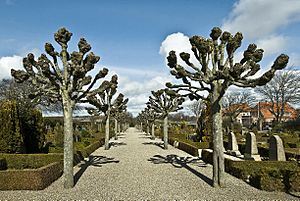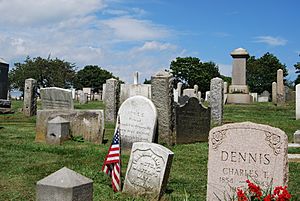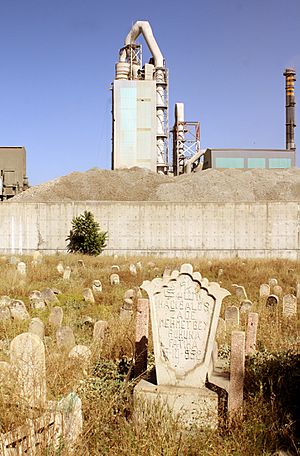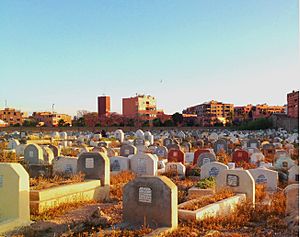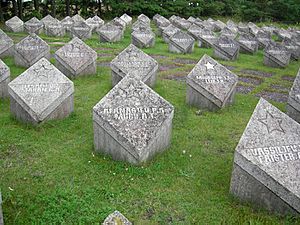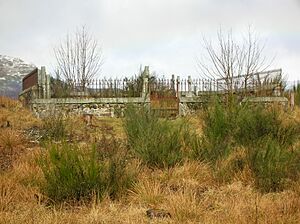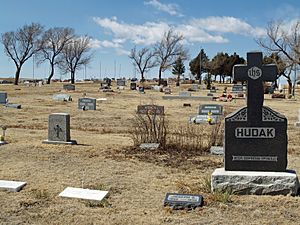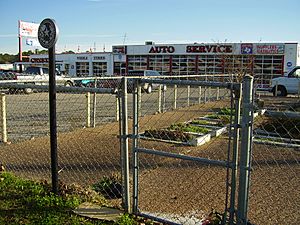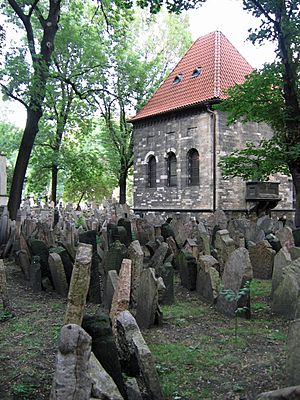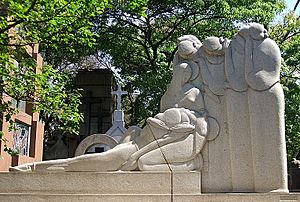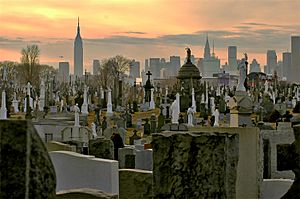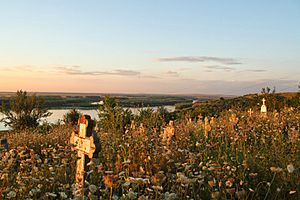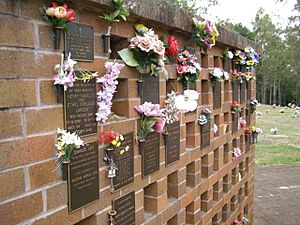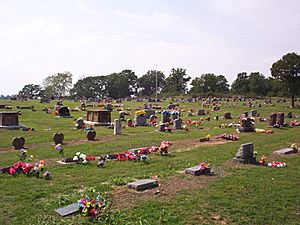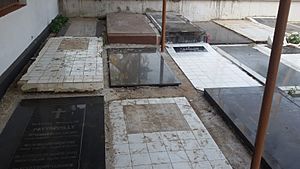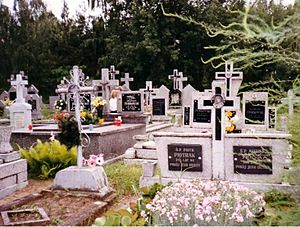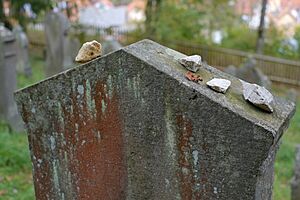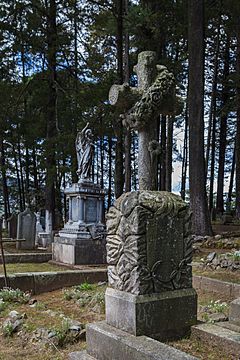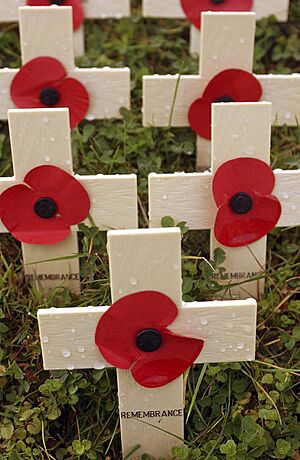Cemetery facts for kids
A cemetery or graveyard is a special place where people who have passed away are buried. The word cemetery comes from a Greek word meaning "sleeping place." This shows that the land is set aside just for burials. The word "graveyard" is often used the same way. But it usually means a burial ground that is part of a churchyard.
People's bodies or ashes can be placed in a grave. This is usually called a burial. They can also be put in a tomb, which is like an above-ground grave. Other options include a mausoleum, a columbarium, or a niche. In many cultures, funeral services happen in cemeteries. These services are different depending on a culture's practices and religious beliefs. Many modern cemeteries also have places for cremation. Some older sites that once had both now mainly do cremations.
Contents
Different Kinds of Cemeteries
There are many styles of cemeteries around the world. Different areas within a cemetery might also have various styles. This shows how burial practices change over time and across cultures.
Urban Cemeteries
An urban cemetery is a burial ground found inside a village, town, or city. Early urban cemeteries were often churchyards. These quickly became full. Burial markers were placed randomly as people tried to fit new graves into any open space.
Later, new urban cemeteries were built. They often had burial plots laid out in a grid. This made them look more organized than old churchyards. Over time, urban cemeteries became more like parks. They were part of making cities look civilized and peaceful.
Many urban cemeteries have multiple burials in the same grave. This happens because urban cemeteries are small. They cannot easily grow due to nearby buildings. Sometimes, new soil was added on top of old graves. This created new burial space.
Monumental Cemeteries
A monumental cemetery is a traditional type of cemetery. It has headstones or other monuments that stand upright. These are often made of marble or granite. They can be about 50 cm tall, but some are over 2 meters high. Sometimes, the entire grave is covered by a slab. This slab might be concrete, marble, or granite. The grave's edges might also have a fence. This fence can be made of concrete, cast iron, or wood. If several family members are buried together, the slab or fence might cover all their graves.
Some people think monumental cemeteries look messy. This is because of the many different monuments and headstones. Also, families are usually in charge of keeping headstones clean. Over time, many headstones are forgotten. They can decay or get damaged.
Cemetery workers find monumental cemeteries hard to maintain. Even with grass between graves, it is tough to use large lawnmowers. Grass often needs to be cut by hand. This costs more money. Tools like string trimmers are used more often. But these can damage the monuments. Cemetery managers sometimes get criticized for damaged headstones. They argue that they are not responsible for headstone upkeep.
Rural or Garden Cemeteries
The rural or garden cemetery style uses landscaping. It looks like a park. Sir Christopher Wren, a British architect, first thought of this idea in 1711. He wanted burial grounds with planned walkways. These paths would give easy access to graves. He also wanted trees, bushes, and flowers planted.
Wren's idea was not immediately popular. But by the early 1800s, churchyards were too crowded and unhealthy. Graves were stacked or reused. Because of this, the first "garden" cemetery opened in Paris in 1804. It was called Père Lachaise Cemetery. These cemeteries were usually outside of town. Land was cheaper and plentiful there. So, they were called "rural cemeteries." This name is still used today. The idea quickly spread across Europe.
Garden cemeteries were not always outside city limits. If land was found in a city, a wall enclosed the cemetery. This gave it a garden-like feel. These cemeteries were often not tied to one religion. They also were not usually next to a church. They looked like beautiful parks, inspired by English gardens. The first garden cemetery in the United States was Mount Auburn Cemetery. It opened near Boston, Massachusetts, in 1831.
Building a garden cemetery was often expensive. So, usually only wealthy people could afford to be buried there. Garden cemeteries often have large monuments, mausoleums, and columbaria. These elaborate memorials sometimes filled the cemeteries too much. This led to the creation of the lawn cemetery style.
Lawn Cemeteries
Traditional Lawn Cemeteries
A lawn cemetery is covered in grass. Each grave has a small plaque. It is usually about 30 cm by 20 cm. The plaque lies flat on the ground at the head of the grave. Families can help design the plaque. But cemetery rules often limit its size and materials. They might also suggest or require a standard design.
Lawn cemeteries usually have many graves in a grassy area. Trees and gardens are often around the edges. Adolph Strauch started this style in 1855 in Cincinnati.
Cemetery managers liked this new style at first. They thought it would be easier to maintain. If the land is flat, large mowers can be used. The flat plaques are below the mower blades, so they are not damaged. However, families often place flowers and other items on the graves. This makes it hard to use large mowers. Cemetery managers try to limit what can be placed on graves. But grieving families often get upset if items are removed. Another issue is grass growing over the plaques. This makes it hard for families to find the grave.
Lawn Beam Cemeteries
The lawn beam cemetery is a newer design. It tries to fix problems of the traditional lawn cemetery. It keeps many benefits too. Low concrete slabs, called beams, are placed across the cemetery. They are about 10–15 cm high. Plaques stand on these beams next to each grave. These plaques are usually standard in size and material. Grass still grows over the graves themselves.
The areas between the beams are wide. This allows large mowers to pass easily. The mower blades are set lower than the beams. So, they cannot damage the plaques. Plaques on the beams are not easily covered by grass. Spaces between plaques let families place flowers and other items. These items are out of the mower's reach.
Natural Cemeteries
A natural cemetery, also called an eco-cemetery or green cemetery, is a new type of cemetery. It is set aside for natural burials. These burials can be with or without coffins. Natural burials aim to be good for the environment. The body breaks down quickly and becomes part of nature. This avoids the environmental cost of traditional burials.
Natural burials often happen in a natural bushland or woodland setting. Because there are many trees, burials happen where they fit best. They are not in neat rows like in other cemeteries. This might mean natural burials use land less efficiently. However, bodies break down quickly in natural burials. So, the grave site could be reused sooner than in other burials. But it is not clear if families will accept reusing grave sites so soon.
Natural cemeteries usually do not have traditional headstones. Instead, a tree or bush might be planted. Or a rock might be placed to remember the person. But families often want to visit the exact grave spot. They also want to read a headstone. Some natural cemeteries let names be carved on natural rocks. But these rocks can be moved easily if they are not very large.
Columbarium Walls
Columbarium walls are common in many cemeteries. They are used because more people choose cremation instead of burial. Ashes can be kept at home in urns. Or they can be scattered in a special place. But these options do not offer a lasting plaque to honor the dead. They also do not provide a place for friends and family to visit.
So, many cemeteries now have walls. These walls are usually made of brick. They have many small, rectangular spaces called niches. Each niche is big enough for a person's ashes. Columbarium walls use land very efficiently. A niche is also much cheaper than a burial plot. A small plaque, about 15 cm by 10 cm, can be placed on the front of each niche. This is usually included in the price.
The writing on the plaques must be small. So, niches are usually placed between 1 and 2 meters above the ground. This makes them easy for adults to read. Some walls have niches closer to the ground. But these are less popular. It is hard to read the plaque without bending down.
Like graves, niches can be assigned by the cemetery. Or families can choose from available ones. It is often possible to reserve nearby niches for other family members. Using adjacent niches allows for a larger plaque. This gives more space for writing. Some columbarium walls are set aside for different religions or for war veterans.
People often like the simple look of a wall of plaques. But leaving flowers is a very common tradition. Mourners leave flowers and other items on top of the walls or at the base. They try to place them as close as possible to their loved one's plaque. Newer columbarium walls are designed to include a clip or loop. This holds a single flower stem or a small bunch of flowers. As flowers decay, they fall to the ground. This does not create a big maintenance problem.
Family Cemeteries
Family or private cemeteries were once common, especially when America was being settled. If there was no public or church cemetery, settlers would find a small plot of land. This was often in wooded areas near their farms. They would start a family burial plot there. Sometimes, several families would agree to bury their dead together. Some of these sites grew into larger cemeteries. But many were forgotten if the family moved away or died out.
Today, it is not common to find groups of tombstones on undeveloped land. But it does happen. As cities grew, more land was developed. Sometimes, old family burial plots were found. Property owners might have to allow family members to visit and maintain these small plots. Cemeteries are sometimes moved for new buildings. But if not, descendants can still visit.
More recently, some families with large estates choose to create private cemeteries. These can be burial sites, monuments, crypts, or mausoleums on their property. For example, the mausoleum at Fallingwater is a private burial site. Burying a body on a property can protect it from future development. These estates are often managed by a trust or foundation. Today, it is harder to start private cemeteries due to state rules. Many require a plan to care for the site forever. Private cemeteries are almost always forbidden in city residential areas.
Many people also bury their beloved pets on their family property.
Cemetery Customs
Flowers
In many countries, people often leave cut flowers at graves. This is common during holidays, birthdays, or anniversaries. Cemeteries usually remove these flowers after a few weeks. This helps keep the area tidy. Some companies offer services to keep graves decorated with fresh flowers all the time. Flowers can also be planted on the grave, usually in front of the gravestone. Roses are a very popular choice for this.
Stones
Visitors to Jewish cemeteries often leave a small stone on top of the headstone. Prayers are said at the grave. The stone is left when the visitor leaves. This is a sign of respect. Flowers are usually not placed at Jewish graves. Flowers fade quickly. Stones show that love, honor, memories, and the soul of the loved one are eternal. This practice was shown in the movie Schindler's List, though not on a Jewish grave in that scene.
Crosses
War graves often have small wooden crosses. A red poppy is usually attached to the center. Messages are often written on these crosses. More formal visits might involve leaving a poppy wreath. Jewish war graves are sometimes marked with a wooden Star of David.
Candles
Placing burning grave candles at a cemetery is a common tradition in Poland. This is mostly done on All Souls' Day. The traditional grave candles are called znicz in Polish.
Images for kids
See also
 In Spanish: Cementerio para niños
In Spanish: Cementerio para niños



